5 Nuclear Weapons
By Professor Candice M. Carter
STUDENT OBJECTIVES
- To further understand the role of unmanned systems in the nuclear realm
- To study Nation-State advances with unmanned nuclear systems
- To develop an understanding of the next generation of warfare
INTRODUCTION
The future battlefield looks different from traditional warfare with the continued advances in unmanned technology. Nuclear unmanned systems are alternatives for intercontinental ballistic missiles (ICBMs) and manned bombers and submarines for nuclear weapon delivery. The advantages of unmanned nuclear weapons are the ability to be deployed to reach further targets at set periods and enable unique attacks that normally would be challenging. Additionally, unmanned weapons increase the precision of targeting an attack. However, the advanced artificial intelligence required within the design of unmanned weapons can make them potentially unpredictable. The technology is not at the stage where it would allow nuclear-armed states to credibly threaten the survivability of each other’s nuclear second-strike capability. (Caves, 2021)
STATE ACTORS
RUSSIA
In 2019, the United States and Russia withdrew from the Intermediate-Range Nuclear Forces (INF) Treaty. After years of discussion, the United States’ withdrawal was precipitated by Russia’s refusal to acknowledge, much less rectify, it’s testing of the 9M729 (SCC-8) ground-launched cruise missile over the ranges permitted by the treaty. (Caves Jr. & Cares, 2021) In May 2020, the United States announced it would withdraw from the Open Skies Treaty in response to a history of Russian violations unless Russia returned to compliance. (Caves Jr. & Cares, 2021) “Responsibility for the deterioration of the Open Skies regime lies fully with the United States as the country that started the destruction of the treaty,” the Russian Foreign Ministry stated in December 2020. (Zherdin, 2022) After the U.S. withdrawal, Moscow sought written guarantees from the remaining states-parties that they would neither continue to share data collected under the treaty with Washington nor prohibit overflights of U.S. bases in Europe, but states-parties dismissed the request. (Zherdin, 2022) The Open Skies Treaty was an agreement among 34 countries regarding what type of technology could fly over their countries. The treaty required specific certifications of equipment.
The United States and Russia have agreed to The New START Treaty (Strategic Arms Reduction Treaty), activated in January 2022. Replacing The SMART Treaty, originally signed in 2010 and expired on February 5, 2021. The 2010 Start Treaty was an agreement between the two countries for nuclear arms reduction and established a limit of deployed strategic warheads. As part of the New START Treaty (which is enforced until 2026), intercontinental and submarine ballistic missile launchers and heavy
Table 5.1 Limits on START, Moscow Treaty, and New Start

Source: (Congressional Research Service, 2022)
bombers are counted under the limits until they are converted or eliminated according to the provisions described in the treaty’s Protocol. (Congressional Research Service, 2022) This differs from the original Treaty by giving both countries greater flexibility to comply by allowing the countries to decide how to reduce forces.
Does The New START Treaty give China an advantage over the United States and Russia? Hong Kong-based military affairs commentator and former PLA instructor Song Zhongping said Beijing might use the five years to narrow the nuclear modernization gap with the US and Russia. (Chan, 2021)
Soviet Union
The 1960s had the growth of nuclear weapons in the United States and Russia, leading to several discussions between the countries regarding taking nuclear action against one another. With the signing of the 1972 Anti-Ballistic Missile (ABM) Treaty, both sides accepted limits to protect themselves from a retaliatory nuclear attack, thus reducing the attractiveness of being the first to strike. (Woolf, 2022) By the end of 1980, the Soviet Union declared they would not be the first to strike in a nuclear conflict. After the accident at the Chornobyl Nuclear Power Plant, Mikhail Gorbachev believed that the use of nuclear weapons would be catastrophic. (Woolf, 2022) The Soviet Union and the United States made great strides to turn away from nuclear weapons and focus on peace and diplomacy.
Russian Federation
After the fall of the Soviet Union, the Russian Federation was formed in its place. The Russian Federation took Russia from a political state to a country. The liberal thinking and embracing of western ideology changed in 1999 when President Vladimir Putin was sworn to what would eventually become Russia’s longest-serving leader and is in his fourth term as president. Over his leadership, Russia has slowly fallen back into a reflection of the past Soviet Union. Putin felt the Russian Federation was weak in the eyes of the world. One of the items that contributed to changing the of being just another country was in 1997. The Russian Federation eliminated the no-first-use pledge of nuclear weapons. It replaced it with the ability of the Russian Federation to use nuclear weapons for protection against attacks from other attacks countries. Eventually, the policy evolved into the Russian Military Doctrine of 2010, allowing for a preemptive nuclear strike. (Woolf, 2022) The 2010 doctrine stated that the main external military dangers to Russia were “the desire to endow the force potential of the North Atlantic Treaty Organization (NATO) with global functions carried out in violation of the norms of international law and to move the military infrastructure of NATO member countries closer to the borders of the Russian Federation, including by expanding the bloc.” (Woolf, 2022) Since that time, Russian President Vladimir Putin’s public stance on nuclear weapons has wavered until 2018. Over the past few years, the development of the Russian nuclear program has accelerated.
Посейдон and Белгород
In March 2018, Russian President Vladimir Putin unveiled to the Russian Federal Assembly the modernized nuclear-armed system, highlighting the development of two new nuclear delivery systems, which, he said, could evade US anti-ballistic missile defenses. (Rosenberg, 2018) This included cruise missiles, intercontinental ballistic missiles, underwater drones, and supersonic jets. Putin strives for Russia to be a world superpower and reclaim former countries part of the Soviet Union.
Figure 5.1 Russian President Vladimir Putin Addresses the Russian Federal Assembly
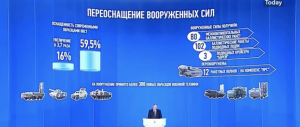
Source: (Rosenberg, 2018)
Status – 6 (Статус-6) is an autonomous, nuclear-armed, and powered unmanned underwater vehicle. Known now as Poseidon ( Посейдон) is one of the six strategic weapons announced in The Project 09851 Khabarovsk special-purpose nuclear submarine, capable of carrying up to six Poseidon strategic drones, which will be launched in the first half of 2021. (Pike, 2021) Poseidon is an ‘Intercontinental Nuclear-Powered Nuclear-Armed Autonomous Torpedo.’ (Sutton H. I., 2022) The Poseidon 2M39 torpedo is still under development; however, it will be an unstoppable nuclear weapon when complete. The modern nuclear weapon is believed to be between 65 to 79 feet long, approximately 6.5 feet in diameter, with a dirty bomb warhead. The mega weapon will have a two-megaton nuclear or conventional payload that could be detonated “thousands of feet ” below the surface. (Woolf, 2022) With the ability to travel underwater past anti-defense systems with ease, Poseidon will cause a radioactive Tsunami that will last for years into the future. Professor Frank von Hippel, a senior research physicist at Princeton University, believes this next generation of Nuclear weapons will show the United States there is no way to escape our mutual nuclear hostage relationship. (Bergan, Papadopoulos, Erdemir, & Ozdemir, 2021) Poseidon is the largest torpedo ever developed in any country. (Sutton H., Covert Shores, 2016) It is twice the size of submarine-launched ballistic missiles (SLBMs) and thirty times the size of a regular ‘heavyweight’ torpedo. (Sutton H., Covert Shores, 2016) The original release date of the deadly torpedo was 2022. However, indicators point to the activation date targeting 2027. There is no other country that can match the creation of this nuclear weapon at this time.
Figure 5.2 Russian Poseidon 2M39 Torpedo
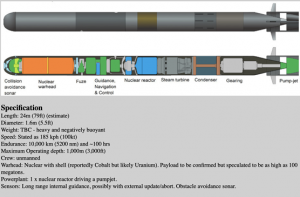
Source: (Sutton H. I., 2022)
When Russian President Vladimir Putin spoke to the Russian Federal Assembly in 2018, it was clear the next generation of Russian nuclear systems would be designed with the ability to bypass any United States missile defense system. Russia has construction underway to build a new military base to hold 30 Poseidon torpedoes and four unmanned nuclear submarines. Per President Putin, the unmanned submarines, Belgorod (Белгород), are intercontinental, the fastest, largest, and noiseless in the world. According to President Putin, unmanned vessels can reach ultra-deep levels and cannot be detected by any current defense system.
Figure 5.3A Belgorod – Russian Unmanned Nuclear Submarine

Figure 5.3B Belgorod – Russian Unmanned Nuclear Submarine

Source: (Sutton H. I., 2022)
Figure 5.4 Belgorod – Russian Unmanned Nuclear Submarine
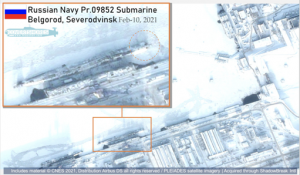
Source: (Sutton H., Covert Shores, 2021)
Nuclear Alert Status
February 27, 2022, Russia’s President Vladimir Putin told his Defense Minister and Chief of General Staff to activate nuclear forces into combat readiness. There is speculation about how this action impacted forces; was it an internal change or an external one? The Pentagon did not see any changes to Russia’s nuclear landscape. Most signals indicate the announcement of the change of status was retaliation for sanctions against Russia for the invasion of Ukraine.
January 2021, Russia accepted delivery of the first of 10 brand-new Tu-160M strategic bombers with updated NV-70M radar and NK-32-02 engines, U.S. Admiral Charles Richard testimony to the U.S. House Defense Appropriations subcommittee April 2022. (Tiron & Musk, 2022)
CHINA
Think of the Chinese use of swarming drones on the seas, in the air, floating nuclear power plants, underwater mining, robot freighters, and anti-submarine UUVs. In the author’s view, they are leapfrogging US technology and antiquating defenses. (Nichols R. K., 2020) It is believed over the next six years, China will increase its nuclear warheads by at least 700. (Moore, 2021), 2021) The current inventory is closer to the numbers of warheads of the United Kingdom and France. Beijing’s nuclear stockpile, which could top 1,000 deliverable warheads by 2030, is designed to match and even surpass the US’ global military. (Moore, 2021) This contributes to China’s goal of being a global superpower by breaking other countries’ alliances with the U.S. and gaining partnerships in the Indo-Pacific Region by 2049. (Moore, 2021), Russia and China declared a new era of partnership against the United States and other members of NATO. Also, both countries have decided to collaborate on the Internet, space, and climate change. They each support the other in the desire to grab land, China for Taiwan, and Russia for Ukraine. Will this new partnership expand to the development of nuclear weapons?
China is closely following the developments of the U.S. Navy’s plans to develop unmanned systems, especially in the underseas. These UUVs are used in various data collection roles in coordination with satellites and other surveillance systems. Evidence points to China exploring nuclear-powered underwater drones and cruise missiles. (Standeford, 2021) China is substantially upsetting the offense-defense balance in underwater warfare. (Carnegie Endowment for International Peace, 2018) China’s growth in the unmanned area includes the ability to detect stealth submarines without exploding their mother surface ships into the danger of sailing within range of Chinese anti-ship missiles. (Carnegie Endowment for International Peace, 2018) The Chinese strongly believe the U.S. uses unmanned systems to collect intelligence on their Strategic Nuclear-Powered Ballistic Missile submarines (SSBN). The Chinese have warned of mistaking these UUVs in the manner of engagement that could escalate to conflict. In 2014, the Pacific countries adopted the Code for Unplanned Encounters at Sea (CUES). With an additional agreement with the U.S, CUES outlines safety rules for air and maritime encounters to prevent potential conflict. However, in 2016 there was an incident in the South China Sea, and China finds this to be a gray area; if the U.S. dares to send underwater drones, China believes they have the right to seize them. (Carnegie Endowment for International Peace, 2018) China’s focus on maritime weapons reinforces its desire to rule Taiwan. Taiwan does not have guaranteed protection from the United States if China should evade it. However, the U.S. has trained soldiers and sold advanced weapons to Taiwan. The policy between the U.S. and Taiwan is vague. One cannot help to think China is watching the U.S. reaction to Russia invading Ukraine very closely to see what they could be up against.
Figure 5.5 China Nuclear Expansion
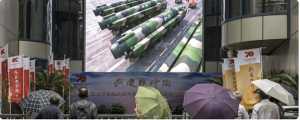
Source: (Tiron & Musk, 2022)
UUVs are ideal for Nuclear powered weapons and bring unlimited possibilities of a range of targets. At the Conference on Disarmament, the United States conference ambassador, Robert Wood, stated that China has been building 110 new missile silos in the country’s northern desert region. (Standeford, 2021) China is one of the leaders in drone swarm capabilities; this is an area of concern for China entering the unmanned nuclear space. In the action of a drone swarm, dozens of small, unmanned aircraft systems fly together, filling the sky. Some are collecting information. Some are identifying ground targets. Others might attack the same targets. (EurAsian Times Global Desk, 2020) A drone swarm can contain upwards of 10,000 drones, making defeating a swarm attack not feasible for humans. China has demonstrated its dominance in this space on numerous occasions, forcing other militaries to create anti-swarm defense systems while perfecting the use of a swarm attack.
Figure 5.6 China Drone Lineup Sharp Sword stealth drone and the Wing Loong Reaper
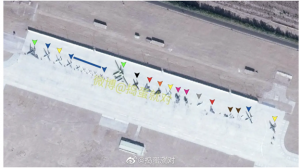
Source: (EurAsian Times Global Desk, 2020)
During the summer of 2021, China tested two nuclear-capable hypersonic missiles in August that circled the globe before speeding toward their target. (Sevastopulo, 2021). [1]The nuclear weapon test demonstrated to the U.S. and the world that China had accelerated its development of nuclear weapons that could go undetected by U.S. anti-ballistic missile defense systems.
China’s nuclear weapon development proceeds to be a driving force for the country to become a competitive global superpower.
OTHER COUNTRIES
The cooperation among NATO and non-EU allies is important in the next generation of warfare. Given the indications by global leading Nation-states that the nuclear arms race has been reignited, there is no doubt that other countries are anxious not to be left behind. Other countries, such as Israel, North Korea, Turkey, etc., plan to develop drones with radioactive impacts. However, North Korea, Israel, Pakistan, and India have nuclear weapons arsenals. France has nuclear weapons, launching submarines and aircraft. The United Kingdom only can launch nuclear weapons via submarine. Overall, the countries of NATO will combine their military powers to defeat the threat from others outside of their alliance. Given the rapid developments from Russia and China with nuclear warheads, the partnerships in developing the nuclear weapons and defenses systems are critical to NATO.
An item to watch: In the current conflict in Ukraine, drone hobbyists are instructed how to modify off-the-shelf drones for military action in a similar fashion to non-state actors. This development should be closely studied for future conflict as next-generation warfare.
CONCLUSIONS
Weapons may be understood as devices that deposit energy on targets. The energy that must be deposited to achieve a given level of damage is relatively insensitive to the type of weapon employed. Nuclear weapons may be characterized by megatons, bullets in terms of muzzle velocity, and particle beams in terms of amperes of current. (Nichols, Mumm, Carter, & Hood, 2020) The next generation of the nuclear arms race reinforces the need to develop international agreements and treaties for unmanned systems (including drone swarm advances) to prevent the threat of nuclear conflict. While aerial drones have limitations with the number of payload constraints, especially commercial, unmanned technology will continue to expand in the sea and space. Unmanned systems can hit targets with precision, especially in areas where normal weapons would have to overcome several technological and environmental challenges.
BIBLIOGRAPHY
Bergan, B., Papadopoulos, L., Erdemir, M., & Ozdemir, D. (2021, July 7). The Weapon That Eradicates Cities by Creating ‘Radioactive Tsunamis’. Retrieved April 4, 2022, from Interesting Engineering: https://interestingengineering.com/poseidon-nuclear-weapon-radioactive-tsunamis-russia
Carnegie Endowment for International Peace. (2018, October 24). The Impact of Future Unmanned Systems – Tides of Change: China’s Nuclear Ballistic Missile Submarines and Strategic Stability. Retrieved April 8, 2022, from Carnegie Endowment for International Peace: https://carnegieendowment.org/2018/10/24/impact-of-future-unmanned-systems-pub-77497.
Caves Jr., J. P., & Cares, W. S. (2021, February). The Future of Weapons of Mass Destruction. National Intelligence Press. Retrieved April 2022 from National Intelligence University: https://ni-u.edu/wp/wp-content/uploads/2021/02/Future_of_WMD_Final.pdf.
Caves, J. P. (2021, February). THE FUTURE OF WEAPONS OF MASS DESTRUCTION. Retrieved April 8, 2022, from National Intelligence University: https://ni-u.edu/wp/wp-content/uploads/2021/02/Future_of_WMD_Final.pdf.
Chan, M. (2021, January 31). China may seek to close the nuclear gap as US and Russia extend the treaty. Retrieved April 3, 2022, from South China Morning Post: https://www.scmp.com/news/china/military/article/3119913/china-may-seek-close-nuclear-gap-after-us-and-russia-agree.
Congressional Research Service. (2022, February 2). The New START Treaty: Central Limits and Key Provisions. Retrieved April 3, 2022, from FAS Project on Government Secrecy: https://sgp.fas.org/crs/nuke/R41219.pdf.
EurAsian Times Global Desk. (2020, August 28). US, China Developing “Super Swarm” Drones With Destruction Power Equivalent To Nuclear Weapons. Retrieved April 5, 2022, from EurAsian Times: https://eurasiantimes.com/us-china-developing-super-swarm-drones-with-destruction-power-equivalent-to-nuclear-weapons/.
James Martin Center for Nonproliferation Studies at Monterey’s Middlebury Institute of International Studies. (2022, January 1). New START Treaty. Retrieved April 3, 2022, from The Nuclear Threat Initiative: https://www.nti.org/education-center/treaties-and-regimes/treaty-between-the-united-states-of-america-and-the-russian-federation-on-measures-for-the-further-reduction-and-limitation-of-strategic-offensive-arms/.
Janes. (2021). JANES ALL THE WORLD’S AIRCRAFT: In-Service. JANE’S INFORMATION GROUP.
Moore, M. (2021, November 3). China is expanding its nuclear weapons force faster than predicted. Retrieved April 8, 2022, from New York Post: https://nypost.com/2021/11/03/china-expanding-nuclear-weapons-force-faster-than-predicted/.
Nichols, R. K. (2020). Chapter 14 Maritime Cybersecurity [Nichols] – UNMANNED VEHICLE SYSTEMS & OPERATIONS ON AIR, SEA, LAND. Retrieved April 8, 2022, from New Prairie Press Open Book Publishing: https://kstatelibraries.pressbooks.pub/nicholsproject/chapter/chapter-14-maritime-cybersecurity-nichols/.
Nichols, R., Mumm, H., Carter, C., & Hood, J. (2020, February 1). Counter Unmanned Aircraft Systems Technologies and Operations – Simple Book Publishing. Retrieved April 8, 2022, from New Prairie Press Open Book Publishing: https://kstatelibraries.pressbooks.pub/counterunmannedaircraft/.
Pike, J. (2021, August 25). Status-6 / Kanyon – Ocean Multipurpose System – Russian and Soviet Nuclear Forces. Retrieved April 3, 2022, from GlobalSecurity.org: https://www.globalsecurity.org/wmd/world/russia/status-6.htm.
Rosenberg, S. (2018, March 1). Russia’s Putin unveils ‘invincible’ nuclear weapons. Retrieved April 3, 2022, from BBC: https://www.bbc.com/news/world-europe-43239331.
Sevastopulo, D. (2021, October 16). China tests new space capability with a hypersonic missile. Retrieved April 8, 2022, from Financial Times: https://www.ft.com/content/ba0a3cde-719b-4040-93cb-a486e1f843fb.
Standeford, D. (2021, July 12). China To Obtain Nuclear Powered Underwater Drones And Cruise Missiles. Retrieved April 5, 2022, from Defcon Level: https://www.defconlevel.com/news/2021-07-12/china-to-obtain-nuclear-powered-underwater-drones-and-cruise-missiles.php.
Sutton, H. (2016, June 25). Covert Shores. Retrieved April 4, 2022, from H I Sutton: http://www.hisutton.com/Spy%20Subs%20-Project%2009852%20Belgorod.html.
Sutton, H. (2021, June 29). Covert Shores. Retrieved April 4, 2022, from H I Sutton: http://www.hisutton.com/Belgorod-Class-Submarine.html.
Sutton, H. I. (2022, March 3). Russia’s New ‘Poseidon’ Super-Weapon: What You Need To Know. Retrieved April 4, 2022, from Naval News: https://www.navalnews.com/naval-news/2022/03/russias-new-poseidon-super-weapon-what-you-need-to-know/
Tiron, R., & Musk, E. (2022, April 4). The US Sees Rising Risk in ‘Breathtaking’ China Nuclear Expansion. Retrieved April 8, 2022, from Bloomberg Quint: https://www.bloombergquint.com/politics/u-s-sees-rising-risk-in-breathtaking-china-nuclear-expansion.
Woolf, A. F. (2022, March 21). Russia’s Nuclear Weapons: Doctrine, Forces, and Modernization. Retrieved April 4, 2022, from FAS Project on Government Secrecy: https://sgp.fas.org/crs/nuke/R45861.pdf.
Zherdin, D. (2022, January). Russia Officially Leaves Open Skies Treaty. Retrieved April 8, 2022, from Arms Control Association: https://www.armscontrol.org/act/2022-01/news-briefs/russia-officially-leaves-open-skies-treaty.
[1] Further information regarding hypersonic missiles can be found in Chapter 12.

